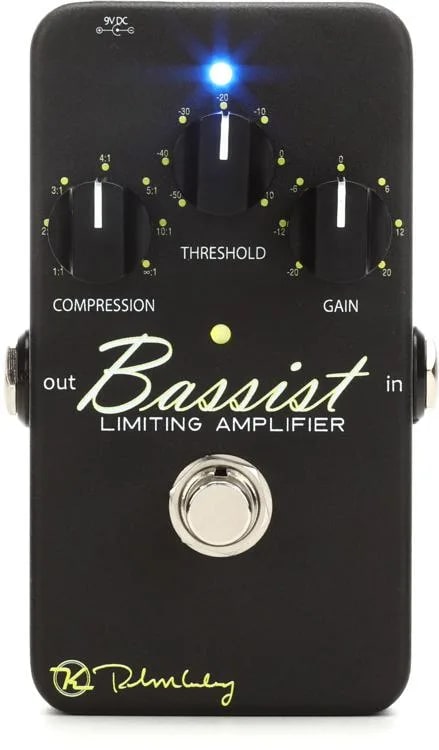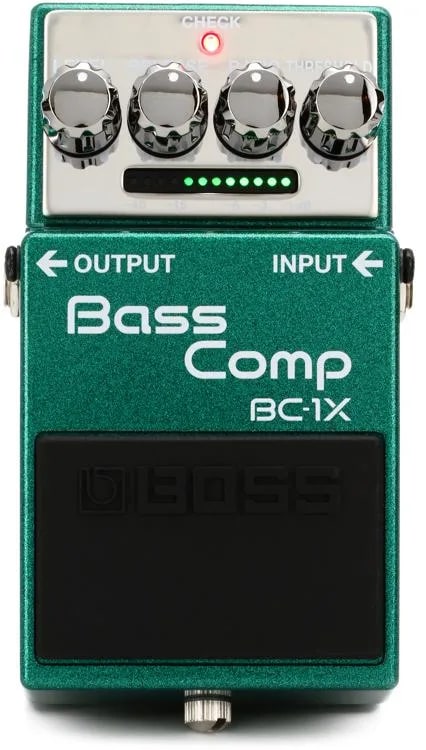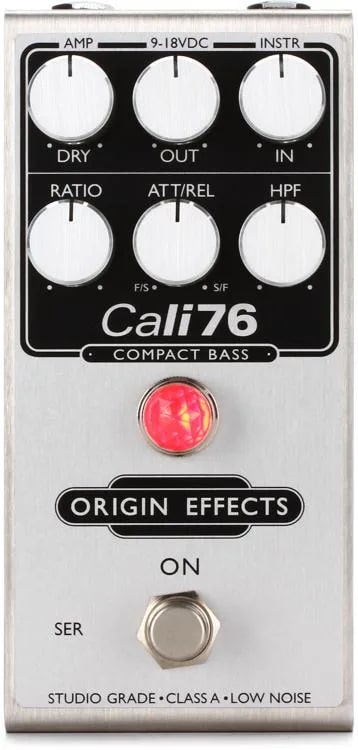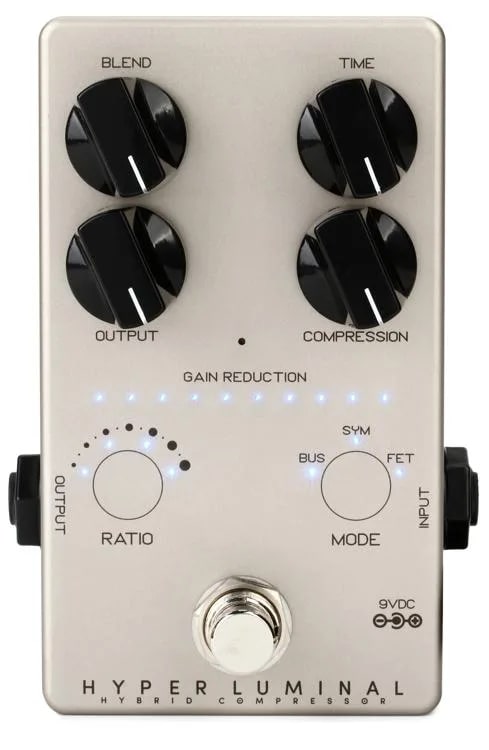When you buy through our links, we may earn an affiliate commission.
Compression makes a huge difference between professional-sounding and amateur-sounding music. It's also especially important for the lower frequencies of bass guitars.
Fortunately, bass compressor pedals have gotten more affordable and easier to use over the years, so they're a fantastic purchase if you're looking to kick your recordings and live performances up a notch
In this article, we've hand-picked 5 bass compressor pedals that are the best value for your money, followed by a buyer's guide so you know what to look out for. The most important factors we've considered are performance quality, ease of use, durability, and cost-effectiveness.
Our number one pick is the MXR M87 Bass Compressor because it brings all these important qualities to the table and makes no compromises.
Grab one of these five bass compressors before your next gig, and you'll be blown away by the difference in how your bass sits in the mix!
Quick Summary of the Best Bass Compressor Pedals
- MXR M87 Bass Compressor Pedal (Best Overall Value)
- Keeley Bassist Limiting Amplifier Bass Compressor Pedal (Best Low-Hassle Option)
- Boss BC-1X Bass Compressor Pedal (Most Durable and Dependable)
- Origin Effects Cali76 Compact Bass Compressor Pedal (Flashiest Choice)
- Darkglass Hyper Luminal Bass Compressor Pedal (Most Feature-Rich Pedal)
Best Bass Compressor Pedals
1. Best Overall Value – MXR M87 Bass Compressor Pedal

SPECS
- Price: $199.99
- Analog/Digital: Analog Compressor pedal
- Power source: 9V Battery (sold separately)
- Controls: Pedal switch, attack, release, ratio, output, input
Looking for a bass compressor pedal for the first time and have no idea where to start? Look no further than the MXR M87 Bass Compressor Pedal.
This renowned pedal has been loved by beginners and pros alike for over ten years. The pedal will instantly help you deliver a consistent and professional-sounding bass tone.
The feature-rich bass compressor has all the controls you'll need—for only $200.
The gain reduction meter sets this pedal apart from others in its price range. We recommend it for bass players who are new to compressor pedals because you can visually see what the pedal is doing, helping you understand how compression works.
The M87 uses Constant Headroom Technology (CHT) to ensure that your bass's full dynamic range is present until the threshold is hit.
By adjusting the parameters to your liking, you can use the M87 as everything from a gain pedal to a limiter. It's so versatile!
2. Best Low-Hassle Option – Keeley Bassist Limiting Amplifier Bass Compressor Pedal

SPECS
- Price: $199.99
- Analog/Digital: Analog compressor pedal
- Power source: 9V DC Battery (sold separately)
- Controls: Pedal switch, compression, threshold, gain
The Keeley Bassist Limiting Amplifier Bass Compressor Pedal just barely missed making it into the first place spot because it, too, is a nearly perfect piece of gear that outperforms most others in its price range.
With only three knobs and a pedal switch, this compressor is perfect for bassists who just want to plug in and have a nice compressed tone with no hassle.
It's nice to have the versatility of the MXR M87 Bass Compressor and some of the other pedals on this list, but there's also a huge benefit to the simplicity and user-friendliness of the Keeley Bassist Limiting Amplifier.
Instead of tinkering different knobs to get the compression justttttt right, you can plug into the Keeley and dial in a fantastic tone in seconds.
The purpose of compression is to reduce the dynamic range (difference between loudest and quietest parts) of an audio single.
The Keeley Bassist Limiting Amplifier Bass Compressor Pedal does this very effectively and is suitable for adding any amount of compression you like to your bass signal.
Despite its low number of knobs, it is still remarkably versatile. You can set the compression level to zero and simply use it as a gain pedal, or you can aggressively squash the dynamics and essentially use the pedal as a limiter.
3. Most Durable and Dependable – Boss BC-1X Bass Compressor Pedal

SPECS
- Price: $239.99
- Power Source: 9V Battery, AC Adaptor (sold separately)
- Controls: Stomp Pedal Switch, Threshold, Ratio, Release, Level
If you're willing to go slightly above the price point of the last two bass compressor pedals, then the Boss BC 1-X Bass Compressor Pedal is worth the extra chunk of change.
One thing that sets this pedal apart from others on the list is its stomp pedal switch.
For those who are used to fast-paced, high-energy stage environments, the stomp switch can be a game changer. You can easily switch the pedal on or off without looking at it, so you can focus all your energy on nailing the riff you're playing.
Like the MXR M87, the Boss BC 1-X features a gain reduction meter. Additionally, you can turn up the level knob to use it as a gain pedal.
Best of all is the durability and build quality of the Boss BC 1-X. Boss pedals have become iconic for their dependability and popularity in pedal boards across all genres.
The controls on the Boss BC 1-X are straightforward and provide an ideal mix of simplicity and adjustability.
There is no knob to adjust attack, which is not a problem for most players, but if you desire an adjustable attack on your compressor pedal, then probably go with a different entry on this list.
4. Flashiest Choice – Origin Effects Cali76 Compact Bass Compressor Pedal

SPECS
- Price: $359
- Power Source: 9V-18V Battery (sold separately)
- Controls: Pedal Switch, Dry, Out, In, Ratio, Attack/Release, HPF
Origin Effects prides itself on bringing "ultra-fat yet articulate bass tones heard on your favorite records" to your live performances and studio recordings. The Cali 76 Compact is the priciest pedal on this list, but if it is in your budget, then it will be money well spent.
Each Origin Effects Cali 76 Compact Bass Compressor Pedal is feature-rich, versatile, and hand-crafted, and inspected to ensure the highest quality build.
So what are some of the things that set this pedal apart from some of the simpler pedals on this list, like say, the Keeley Bassist Limiting Amplifier? Mostly, it's the amount of tone control this pedal offers.
For starters, the dry knob allows you to blend in some of the uncompressed signal with the compressed signal. The result is comparable to how parallel compression would affect your signal in a DAW.
The HPF knob stands for high pass filter, and it can be very useful, especially if you only want the higher frequencies of your bass signal to be leveled out.
Imagine being able to play slap bass as aggressively as you want without having to worry about that dreaded high-end peaking.
With the high pass filter, you can keep your low end untouched while your high-end flourishes get squashed so they don't hurt the audience's ears.
When considering where on your pedalboard to put the Cali 76 Compact, keep in mind that the input and output jacks are both at the top of the pedal.
Aside from all that, this is simply a well-made piece of gear that earns points for durability and overall performance. For more seasoned players who need very specific tone control, this is the pedal we recommend.
5. Most Feature-Rich Pedal – Darkglass Hyper Luminal Bass Compressor Pedal

SPECS
- Price: $299.99
- Power Source: 9V Battery (sold separately)
- Controls: Pedal Switch, Blend, Time, Output, Compression, Ratio, Mode (Bus, Sym, Fet)
When it comes to dialing in a specific tone with extreme accuracy, the Darkglass Hyper Luminal Bass Compressor Pedal is hard to beat.
This pedal offers remarkable versatility because it is an analog pedal with digital modeling capabilities. It can digitally recreate the tones associated with three iconic compressors: Bus, Sym, and Fet.
The Bus setting is modeled after the SSL Master Bus Compressor and provides a clear, transparent tone.
The Sym setting is modeled after the original Darkglass Super Symmetry compressor, which can be used, among other purposes, to fatten and thicken your bass tone.
And finally, the Fet setting is based off of an 1176 compressor and has a warm and classic-sounding tone.
Just in case this wasn't enough tone control for you, the Hyper Luminal is also compatible with its own custom software, Darkglass Suite, which can be used to assign new parameters to the control knobs.
For example, you can add side chain compression with a high pass filter so that only the high frequencies get compressed.
Alternatively, you can adjust the default attack and release settings in case you prefer a specific attack/release time.
Best Bass Compressor Pedals Buyer's Guide
If you're new to bass guitar pedals in general, then compressor pedals are the perfect place to start.
Of all the most common guitar FX pedals, compressor pedals are the most widely useful across most genres and situations. They may not be as attention-grabbing as a fuzz pedal or delay pedal, but when it comes to bass, they are far more useful.
Here are the most important things to look out for when choosing the right bass compressor pedal for you.
Price Point
The price of the pedal is probably the first thing most bass players will consider.
It can be tempting to spring for the super budget options out there, but we recommend not venturing any lower than $200 or so because that is the point where you start getting into the industry standard bass compressor pedals.
As a rule of thumb, if you spend $200 or more on a bass compressor pedal that has good user reviews, it should have everything you're looking for.
Then the question becomes, is it worth it to spend more than $200 to get some of the features that come at higher price points? Well, that depends on what features are important to you.
Features
What specific features do you want on your bass compressor pedal, and are they worth a higher price tag?
Take the Darkglass Hyper Luminal Bass Compressor Pedal, for example: At $300, it is considerably pricier than some of the cheapest options on this list, but it also provides more tone control.
However, having fewer features is not necessarily a bad thing. Many players prefer simplicity and the ability to dial in a clean, compressed signal quickly.
The Keeley Bassist Limiting Amplifier, for instance, has only three knobs but is still a powerhouse of a compressor pedal.
The only real job of a compressor is to level out your signal so that you're free of unwanted peaking. All the pedals on this list do that very well, so the amount of customizability and tone control you want just comes down to preference.
Durability
Everyone wants their gear to last a long time. The durability of the pedal is one of the most important things to consider when making your purchase because pedals are small, easily dropped, and often transported between venues and studios quite frequently.
The fact that pedals are switched by being stepped on makes them inherently prone to taking a beating. Fortunately, most pedal manufacturers understood this and made sure to construct durable pedals.
Every pedal on this list has good build quality and will probably last you many years. The Boss BC 1-X Bass Compressor Pedal, in particular, is renowned for its durability and strength.
Ease of Use
If you are relatively inexperienced with compression, then you might prefer a pedal that is less feature-rich.
The Darkglass Hyper Luminal Bass Compressor Pedal offers an array of tone control options, but it is also the hardest to use for beginners.
A compressor's job is simple at the end of the day, so it's okay if your compressor pedal is simple as well. Especially if your bass guitar rig already has a lot of tone controls, then including tone control knobs on your compressor pedal might leave you with an embarrassment of riches.
As long as your pedal can provide clean, transparent compression, then it is doing its job.
Frequently Asked Questions (FAQs)
What is compression?
Compression, simply put, is the process of reducing the dynamic range of an audio signal. A track that is compressed will sound more leveled out so that the loudest and quietest parts of the track are closer to each other in volume.
The more compressed a track is, the less dynamic range it will have.
Compression is used on most, if not all, of the individual tracks in professionally produced songs. This is because compressed tracks tend to sit better in the mix.
Why is compression important?
You'll often hear people say that compressors "glue" your tracks together.
When used properly, compression will help make all the tracks in a song feel like they are coming from the same space rather than competing and trampling over each other for your ears' attention.
This means that compression is especially important for lower frequencies or bass tones because bass is inherently a support instrument. How a bass part sounds in the context of the full song is far more important than how it sounds by itself.
But there's another reason compression is so essential for bass guitars, and that is the fact that unwanted peaking, or just a signal that is too loud at times, is hard to avoid without a compressor.
Say you're switching back and forth between fingerstyle and slap bass during a show. If you do not have a compressor, then the slap bass part will be much louder than the fingerstyle part.
This means that unless you have exceptional dynamic control, your bass will be too loud in the mix during the slap parts or too quiet in the mix during the fingerstyle parts.
But with a compressor, you can play in any style you want, as loudly or softly as you want, and rest assured that the signal will be within the dynamic range you desire.
This is extremely beneficial in both a live setting and a studio setting.
Is it worth getting a compressor pedal?
Absolutely. If you already have a bass guitar, cable, and amp, then a compressor pedal is arguably the next piece of gear to buy.
Do different styles of music need different compressors?
All of the compressors on this list are versatile enough to be used for just about any style of music. Compression is used across all genres, and pedal manufacturers know this, so typically, they design their pedals to be used for any genre of music.
That said, some styles of music lend themselves to compression more than others. Slap bass, for example, tends to have a wide dynamic range, so a high amount of compression is preferable.
Do I need a compressor pedal if my amp already has a built-in compressor?
Short answer: No.
If your amp already has a built-in compressor that you are happy with, then adding a compressor pedal to your signal chain might be redundant.
An exception to this will be if you desire a specific tone that a compressor pedal provides, one that you cannot achieve with just your amp.
What is the ideal compression ratio for bass?
Ratio determines how much compression is added to the signal once the threshold is passed.
If you have a 1:1 ratio, then there is no compression. If you have an infinity:1 ratio, then the compressor is acting as a limiter.
The ideal compression ratio for bass depends on how squashed you want the dynamics to be. In most cases, a ratio between 4:1 and 12:1 will be suitable.
There is no one size fits all value for any parameter on a compressor pedal, so just use your ears to find out what sounds best for your situation.
Can a compressor pedal be used for both live performances and studio recordings?
Yes. Compressor pedals are useful for both live performances and studio recordings.
The same principles apply to both of these situations, so your knowledge of compression will apply to both as well.
How do I set up my bass compressor pedal properly?
Again, there is no one-size-fits-all setting for a bass compressor pedal, but this is a good rule of thumb to dial in the tone you're looking for quickly.
Start with no compression and set the threshold to the point where the signal sounds the same whether the compressor is bypassed or not.
Then you can slowly adjust the amount of compression, threshold, and other parameters like attack and makeup gain so that you can hear the difference between the compressed and uncompressed signal easily.
This will help you hear the effect your compressor pedal is actually having and get you more in touch with the controls of your pedal.
Conclusion
A compressor pedal is a worthy addition to any bassist's gear collection. It will make any pedal board or bass rig a force to be reckoned with.
If you're looking for a studio-grade compressor that won't break the bank, then the MXR M87 should have everything you need.
But any of the items on this list will provide studio-quality compression, so it's just a matter of finding which output controls are most important to you.
A bass compressor pedal is a purchase you can feel good about because, for many players, it can give you that professional-sounding edge you've been looking for.
